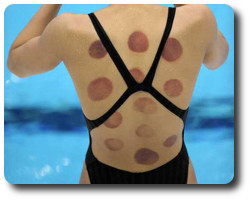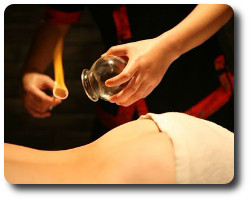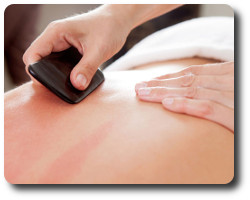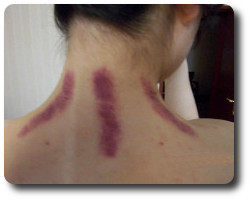There are three ancillary techniques that are usually included under the term acupuncture. Since they tend to leave marks they are less popular among western audiences who are often more concerned for appearances so I find alternative methods where possible. CuppingCupping is when suction cups are places on points of the body. It originates from ancient Egypt where cups were used to "expel evils" by drawing them to the surface. They passed this knowledge to the Greeks where it remained a mainstay of western medicine for millennia. It first entered Chinese medicine in the writings of the 3rd century alchemist Ge Hong. Today cupping is divided into wet and dry types. Wet cupping uses the suction to facilitate bleeding and has become popular in Islamic circles where it is known as Hijama. Chinese medicine tends to favour dry cupping where the cups are used on unbroken skin and results in bruise-like circular marks that fade over time. Dry cupping can also be divided into static and moving cupping depending on whether the cups are fixed in one place, or moved around over the skin like a kind of suction massage. Another type, unique to acupuncture, is where cups are placed over needles, combining the effect of both treatments at one point. |
||
 Modern Cupping |
 A Chinese Olympic athlete with cupping marks on her back |
 Traditional "Fire Cupping" where a flame creates the vacuum |
Gua Sha 刮痧Gua sha ("scraping rash") is a similar procedure to cupping with similar aims and effects but uses a blunt object (traditionally the edge of a soup spoon) that is scraped on the skin until redness arrives. Some western physical therapists have adopted this technique referring to it as "Instrument Assisted Soft Tissue Mobilization" or "Graston Technique". Like cupping this usually leaves markings that fade over a few days but in straight lines instead of circles. A similar method without tools is Jiusha 刮痧 ("grasping rash") where the skin is repeatedly grasped to increase circulation to the surface. |
||
 A Gua sha tool |
 Gua sha marks |
 Full back Gua sha |
"Plum Blossom" TechniqueThe "seven star" or "plum blossom" needle is a tool used to stimulate the skin, similar to derma rollers or stamps used in cosmetic clinics which are sometimes used in their place. It is similar to bundles of sticks or nettles used stimulate the skin other traditional therapies. It looks like a small plastic hammer with a spiked head that is tapped against the skin until redness arrives. |
||
 A "Seven Star" needle |
 A derma-roller |
 Marks left afterwards |
|
I consider these as somewhere between massage and acupuncture: they work on the surface of the skin like massage but utilize tools like acupuncture does to have a stronger effect. The marks they leave can also be seen as crossing the line between medicine and body art, etching the points and meridians we have been working on, to bring our mind back to the treatment for the next few days. |
||